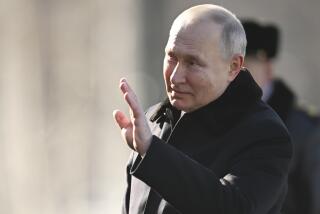Arms Reduction Stressed Over Non-Proliferation
- Share via
Elliot L. Richardson’s article (Editorial Pages, July 25), “Let’s Redouble Non-Proliferation Efforts,” is not convincing. The real issue before the signatories to the Treaty on the Non-Proliferation of Nuclear Weapons at their meeting later this month in Geneva--the third since the treaty was ratified by the United States in 1970--is not arms proliferation, but arms reductions until the last nuclear warhead has been dismantled.
Article VI of the treaty calls for negotiations “in good faith” looking to “nuclear disarmament” and a treaty “on general and complete disarmament under strict and effective international control.” Richardson and his United Nations Assn. of the U.S.A., would have the United States stop testing its nuclear weapons before the Soviets do, an action that properly has been called a booby trap.
For 30 years, as Herbert York brought out in his objective review of nuclear-arms negotiations (Scientific American magazine, October, 1983), the United States has repeatedly offered to reduce its nuclear armaments concurrently with Soviet reductions, subject to mutual, mandatory, and intrusive on-site inspections. The Soviets have agreed to reductions verified only by air and seismic surveillances. While there is reasonable consensus that such limited verification methods would suffice to detect arms buildup, no one has suggested that they would be sufficient to assure arms reductions until the last warhead was dismantled, the objective of the Non-Proliferation Treaty.
If the treaty is to survive, its signatories must be reminded that America’s arms-reduction offer (which now includes chemical weapons), with its realistic and reasonable verification requirement, is the only way to protect each nation’s future generations from the actions of other nations’ future leaders who cannot be depended on to respect promises they did not make.
The Soviets’ refusal to accept intrusive inspections, and that refusal alone, has stood for 30 years, like an inverted vodka bottle, between the world and surcease from the incubus of nuclear holocaust. A consensus at the August meeting could topple that bottle.
WILLIAM L. MOORE
Hemet
More to Read
Sign up for Essential California
The most important California stories and recommendations in your inbox every morning.
You may occasionally receive promotional content from the Los Angeles Times.













